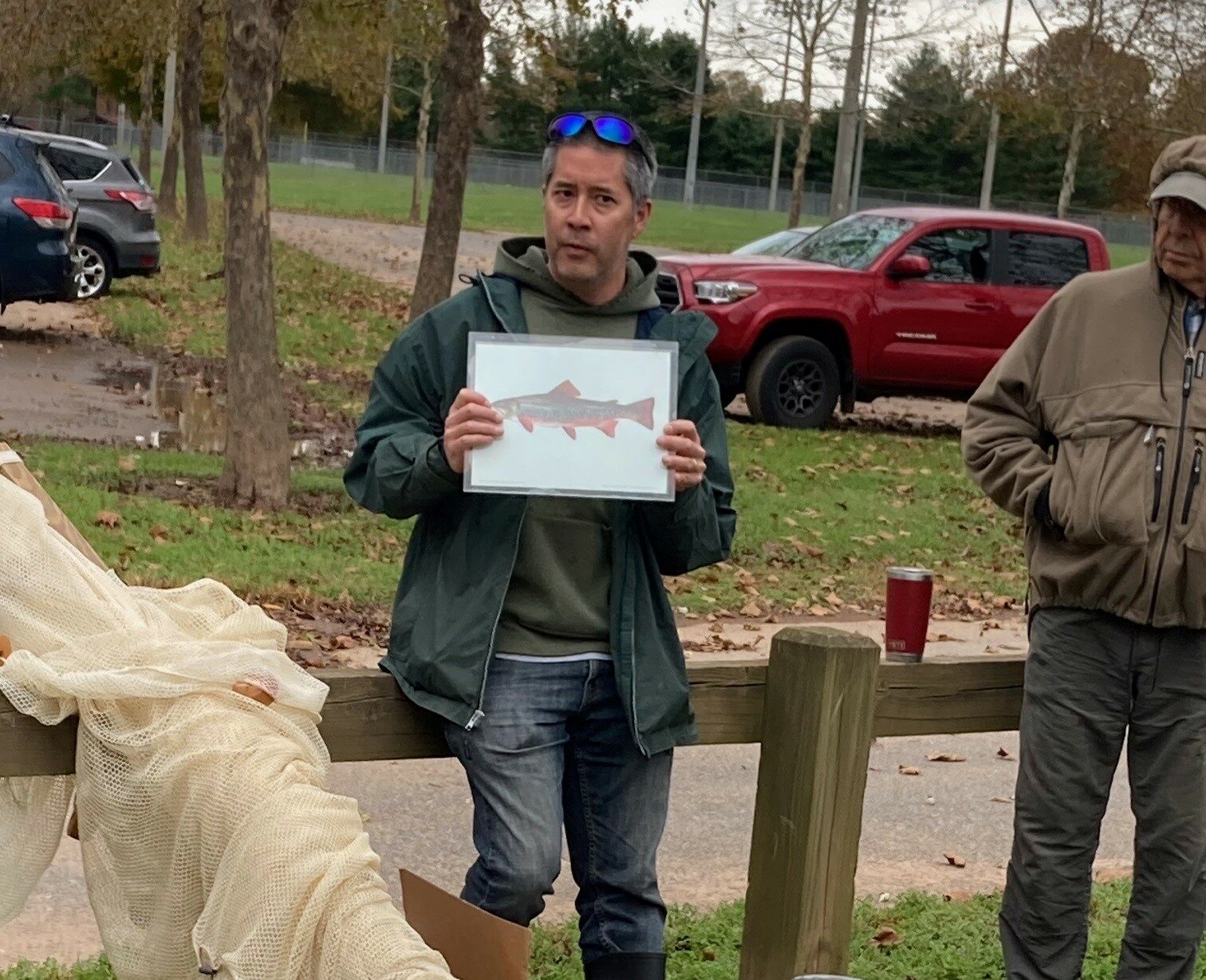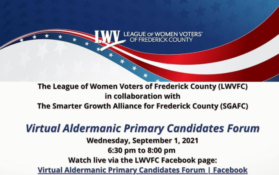
 Envision Frederick County is part of the Smarter Growth Alliance for Frederick County. Our group worked with the Frederick County League of Women Voters to ask questions of the environment to the candidates.
Envision Frederick County is part of the Smarter Growth Alliance for Frederick County. Our group worked with the Frederick County League of Women Voters to ask questions of the environment to the candidates.
Below is an edited summary of what we heard in tonight’s forum:
Frederick County has an active (volunteer) Climate Change Working Group which the City is part of. Their vision is a self-sustaining community independent of fossil fuels; carbon neutral in energy consumption by 2050. Do you think the city should support their efforts to reduce greenhouse gas emissions? If yes how?
Michelle Shay: We all want to support appropriate policies. At the same time it is important to remember …the kinds of monies we are putting forth. Many people think it’s a crisis right now and some don’t see that it’s the highest priority. Over 30 years, getting away from fossil fuels, they are wonderful ideas, but I don’t know how realistic and how safe it is. For example a storm like tonight and losing electricity and energy services, we need to make sure our needs are still met.
Derek Shackelford: We see the effects of climate change happening right now. We see our own infrastructure with flooding. The city by 2050, can accomplish (the goals). You have to have goals. Climate change has health and safety and economic effects. For people in poverty, they are affected greatly by access to healthy food and climate change and GHG reduction is important for the city to have a robust information process as well as education process with climate change info.
Ben MacShane: Climate Change, as the sponsor of the resolution for the city, I of am and remain in strong support. This is a paramount priority for our community, nation and world.
In 2007 Mayor Holtzinger committed the city to participate in the State Urban Tree Canopy with the goal of 40% canopy coverage by 2030 within the municipal boundary. The latest assessment in 2017 showed that the city had reached 20% coverage. Do you think this goal is realistic and if yes in what ways can the city achieve the 40% goal by 2030?
Derek Shackelford – Similar to climate change, tree canopy is important to safety and the protection of planet.
Chris Sparks: The more trees we have and more green our community is, the more bastion Frederick has against climate change. Just look out your window to see the impact of climate change.
We should make the Market Street Mall, turning Market Street to a pedestrian-only zone from All Saints to 3rd. Keep the cross streets open to allow traffic to flow and people to access the garages, and use the reimagined space to plant trees, give space to artists, and increase quality of life for residents and visitors alike.
Residents are concerned about the walkability and livability of the city. Do you have any goals for increased walkability and livability of the city? What are your specific plans to address the issue?
Kelly Russell: We should continue to connect shared use path system, funded by city, state and federal and new development, enhance bike safety, protected bike lanes and how development occurs. Building new development with mixed use and not segregated use. Putting services and goods where people are living.
Michelle Shay: When we look at growth and development and look at maintaining we have to consider these issues hand in hand. A lot of bricks are coming up downtown you can easily trip on. There is reasonably ample parking but not everyone can afford to park in garages; for folks that choose not to , they will go on the streets. With the outdoor seating areas, I support what we had done (outdoor dining areas) to the small businesses affected by covid, it was a necessary thing to do. Its not a necessary thing to do with opening up. It does get in the way of people being able to walk around downtown.
Robert Fischer: Walkability and livability: it goes along with one of my community pillars, we should have options in city especially for very young and elderly to take safe walks. New areas and developments should have walking paths , and bicycle paths; we need to fix those areas downtown and work with the businesses to fix all the broken brick walkways. For hhandicapped, trying to get through the popup dining, its difficult and we should think about how people can walk through that area.
The city has been planning a 4-lane road through the Superfund site at Ft. Detrick’s Area B, as one of the alternatives to complete the Christopher’s Crossing city bypass. What is your position on this proposed road? How would you address the environmental and public health concerns?
Katie Nash: Not in favor of the proposed road as currently (proposed) — I would look to find a reasonable solution we can all agree on. Livable Frederick came before comprehensive plan goals that talk about livability, transportation and neighborhood quality. She encouraged all to agree to follow these goals.
Ben MacShane: The Area B portion of Fort Detrick within city limits has a horrendous and disturbing history with buried toxic materials. Disturbing that it was literally covered up with dirt and left unsecured for decades. It’s important to connect roadways on west side of city, but that can only happen in an environmentally and ecologically safe way. It’s hard to imagine how to find a way that a path through area b is safe. Any development will require environmental analysis that would need to be approved by Maryland Department of the Environment, EPA, Fort Detrick and the military and city staff. I will not support an unsafe path through that part of the city.
In 2020, the City of Frederick has declared that a climate emergency threatens the city, and has developed a DRAFT Climate Action Plan. In what ways can the city communicate with and educate residents about the efforts being made by the city/county joint Climate Emergency Mobilization Workgroup?
Chris Sparks: An undervalued opportunity is communication with the NACS. A group of citizens passionate about the city…whether it’s climate change, economic conditions or increasing complex covid response–if you want Frederick to be great, empower the people who believe that it is . Start with the NACs.
Ben MacShane: We are decades behind already; one important thing the city needs to do is modelling: we are already transitioning our fleet of vehicles to electric vehicles. We need to be moving forward with electrical vehicle charging, green stormwater management and move forward with the composting programs. The city needs to model and normalize.
Donna Kuzemchak: It’s essential for everything we do in the city. The NACS are the best way to do this, like a telephone tree, they can share information with the public and bring info back to City Hall. We are in a climate emergency now. We need to take care of business now.